Equipment
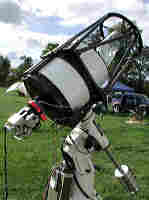 This
is my current setup consisting of a 16" f/8.3 R C Optical Systems Ritchey-Chretien
including field flattener and rotator, an SBIG STL11000M CCD camera including
the adaptive optics unit (AO-L) on Don Goldman's manual off-axis guider (MOAG),
and an AstroPhysics AP1200GTO-CP3. All this sits on Advanced Telescope Systems
(ATS) piers - I use their portable pier at Cherry Springs State Park PA or wherever
I travel and I also have their permanent pier at my getaway home in the Pocono
Mountains of Pennsylvania, the Pocono Palace. I recently acquired a Takahashi
Epsilon E-180 for wide field imaging but it's not yet integrated into the system.
This
is my current setup consisting of a 16" f/8.3 R C Optical Systems Ritchey-Chretien
including field flattener and rotator, an SBIG STL11000M CCD camera including
the adaptive optics unit (AO-L) on Don Goldman's manual off-axis guider (MOAG),
and an AstroPhysics AP1200GTO-CP3. All this sits on Advanced Telescope Systems
(ATS) piers - I use their portable pier at Cherry Springs State Park PA or wherever
I travel and I also have their permanent pier at my getaway home in the Pocono
Mountains of Pennsylvania, the Pocono Palace. I recently acquired a Takahashi
Epsilon E-180 for wide field imaging but it's not yet integrated into the system.
This system operates unattended so I can
get a decent night's sleep either in my van when portable or in the Palace when
I'm up there. I use my own CCDNavigator
for selecting targets and planning imaging sessions and CCDAutoPilot3
for executing them. In addition I use the RCOS TCC to manage the telescope
fans, focuser and rotator, FocusMax for focusing, PoleAlignMax for getting polar
aligned, MaxImDL for camera control and TheSky6 for mount control.
I recently built the "Out Haus
Observatory" at our getaway home in the Pocono Mountains. As you
can see, it consists of two sections that slide apart to uncover the telescope.
By parking the telescope vertically, a very small footprint is possible, the
Out Haus Observatory is a mere 3' wide by 6' long
and is 5' tall at the walls, 6' tall at the center. I recently (12/2007) motorized
the Out Haus Observatory so I can close it from inside our home. Since the two
sections are sized and look like outhouses the name should be obvious. But if
not, the "First Light" photo sez it all....
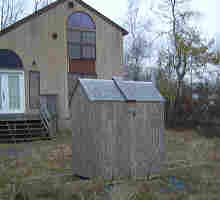
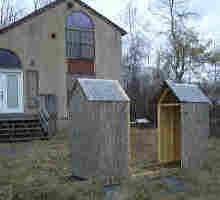
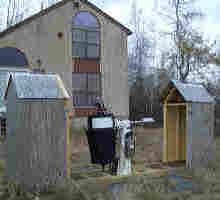
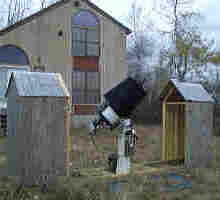
"First Light"

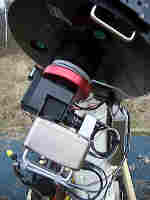
Earlier Systems
My brother in law, John Weaver, got me
interested in astronomy while I was in graduate school (circa 1974). He really
loved astronomy and infected me with it.
I started doing astronomy after coming to
Bell Laboratories in 1978 with a 10" f/6 newtonian which I assembled from
commercial components. It was first placed on a homemade fork mount made of
2" pipe. I began almost immediately to attempt
astrophotography. My first photograph used the 10" f/6 fork mounted newtonian
with Tri-X at the prime focus. It was not motorized but I had rigged a tangent
arm and a manual crank which I turned by hand for the right ascension drive!
I simply taped the Tri-X over the end of the focuser, started cranking and pulled
a scarf off the end of the tube! My first astrophoto was of M13, you can see
that here.
I met my good friend Frank Loso at Stellafane
in 1980. Frank has probably had the greatest "Astronomical" influence
on me over the years. Kay Sears was with him at the time. They invited me to
a S*T*A*R meeting and the rest is history. Kay was a good mentor and always
had a kind word for my crazy ideas. Never critical, Kay was always interested
in whatever you were trying to do and would always have a good suggestion for
you. Kay passed away in 1999, I will always miss him.
When the Dobsonian era started, I converted
the 10" to a Dob. My friend Larry Campbell in S*T*A*R
has that scope now. I replaced it with a Celestron C8 which I used for several
years until I bought a Meade 7" LX50 Maksutov. Some might say this was
steady down-hill progress!
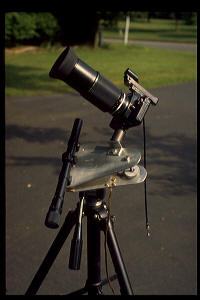
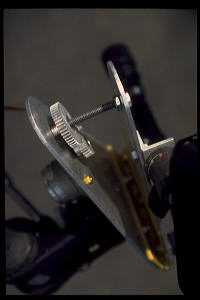 I
also did a lot of barndoor photography, first with a manually driven hand crank
(I still have this and use it on occasion) and later with the slick little homemade
motorized barndoor shown here. This barndoor has been around the world several
times including two trips to Australia. It uses a curved bolt drive.
I
also did a lot of barndoor photography, first with a manually driven hand crank
(I still have this and use it on occasion) and later with the slick little homemade
motorized barndoor shown here. This barndoor has been around the world several
times including two trips to Australia. It uses a curved bolt drive.
I did some manual guiding with the C8 using
an off-axis guider for both prime focus and piggyback photographs but can now
only find a few of the images. During all of this era, I used Ektachrome 400
film
During 1998, I got inspired to do some "real"
astrophotography thanks to David
Segelstein. David is a friend and fellow club member of S*T*A*R and has
taken some really fine astrophotographs. Another really great fellow S*T*A*R
imager is Gordon Waite,
check out his CCD images.
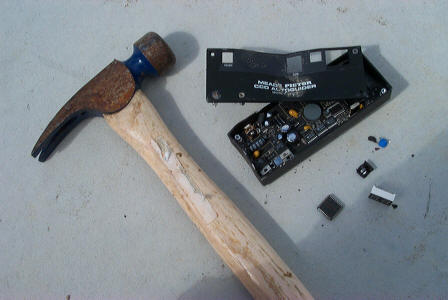 At
the outset, I tried this with my LX50 Mak and a Meade 410XT CCD camera but this
proved to be an impossibility due to the pathetic drive in the LX50 and its
slow f/15 optics. There was around 120 arcseconds of periodic error and much
of it was very erratic and fast which made it impossible to guide accurately.
I also tried to use the Meade 201XT autoguider, a nightmare I hope others will
avoid. The 201XT holds the record as the least usable product in this hobby.
I could write a book about this. If you want to autoguide, get the SBIG ST-4
or STV. This photo shows what I wanted to do to my 201XT (kudos to Rich Michaels
who actually smashed his 201XT out of frustration).
At
the outset, I tried this with my LX50 Mak and a Meade 410XT CCD camera but this
proved to be an impossibility due to the pathetic drive in the LX50 and its
slow f/15 optics. There was around 120 arcseconds of periodic error and much
of it was very erratic and fast which made it impossible to guide accurately.
I also tried to use the Meade 201XT autoguider, a nightmare I hope others will
avoid. The 201XT holds the record as the least usable product in this hobby.
I could write a book about this. If you want to autoguide, get the SBIG ST-4
or STV. This photo shows what I wanted to do to my 201XT (kudos to Rich Michaels
who actually smashed his 201XT out of frustration).
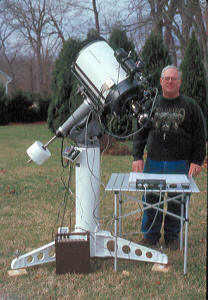 Anyway,
in 1998, I cashed in the LX50 and bought the system you see here. The MI-250
is a terrific mounting that can carry all sorts of optical tubes. The MI-250
has only 6-7 arcseconds of periodic error, what an amazing mount.My first OTA
for the MI-250 was the Meade 12" f/10 SCT. I started out using it for astrophotography
along with the Lumicon Giant Easy Guider but the images just weren't as good
as I was seeking, the star images were bloated and irregular due to coma and
other abberations. But the 12" is good for visual observing so I still
have it.
Anyway,
in 1998, I cashed in the LX50 and bought the system you see here. The MI-250
is a terrific mounting that can carry all sorts of optical tubes. The MI-250
has only 6-7 arcseconds of periodic error, what an amazing mount.My first OTA
for the MI-250 was the Meade 12" f/10 SCT. I started out using it for astrophotography
along with the Lumicon Giant Easy Guider but the images just weren't as good
as I was seeking, the star images were bloated and irregular due to coma and
other abberations. But the 12" is good for visual observing so I still
have it.
I also use an old Nikon F2 which is equipped
with the highly vaunted 6x viewer and a "D" focusing screen. I focus
using a ronchi grating in a homemade knife-edge focuser. I built this using
a cheap 2x telextender for the Nikon so it just attaches directly on the t-ring.
It uses a t-threaded section which can be adjusted. To calibrate it, I used
a piece of film under a glass plate directly on the back of the camera.
When fully assembled, this puppy weighs
in at 230 lbs but I can pack all of it in my car. Yep, it completely fills the
trunk and most of the back seat!. I also use a 120 A-H RV battery to power all
this stuff. It can get me through a couple of night observing without a recharge.
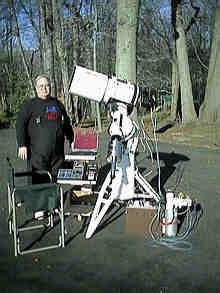 This
is my BRC-250 AP1200 6x9 film setup. The Takahashi BRC-250 is a 10" f/5
astrograph (Baker-Ritchie-Chretien) that I purchased during August 2000 from
Herb York at Anacortes. The mounting is an Astro Physics AP1200GTO that I purchased
used during 2002. The Mitsuboshi off-axis guider couples to an STV for guiding
and to a 6x9 vacuum film back. This came from Ted Ishikawa at Hutech. I use
two film backs, each have purge and vacuum fittings.. The vacuum keeps the 6x9
film flat against the backplate. On the ground to the right is the nitrogen
tank and the vacuum pump. The STV and my notebook PC are sitting on a homemade
stand that doubles as a cart for the battery (next to the nitrogen tank). The
pier is the Advanced Telescope Systems 10" pier with a height of 30".
The battery is a deep cycle marine battery with 180 A-H rating. It can get me
through a night easily, sometime two. Built into the battery box is a dew controller
that measures the temperature of the optics and that of the air. It keeps the
optics slightly warmer than the air so dew does not form.
This
is my BRC-250 AP1200 6x9 film setup. The Takahashi BRC-250 is a 10" f/5
astrograph (Baker-Ritchie-Chretien) that I purchased during August 2000 from
Herb York at Anacortes. The mounting is an Astro Physics AP1200GTO that I purchased
used during 2002. The Mitsuboshi off-axis guider couples to an STV for guiding
and to a 6x9 vacuum film back. This came from Ted Ishikawa at Hutech. I use
two film backs, each have purge and vacuum fittings.. The vacuum keeps the 6x9
film flat against the backplate. On the ground to the right is the nitrogen
tank and the vacuum pump. The STV and my notebook PC are sitting on a homemade
stand that doubles as a cart for the battery (next to the nitrogen tank). The
pier is the Advanced Telescope Systems 10" pier with a height of 30".
The battery is a deep cycle marine battery with 180 A-H rating. It can get me
through a night easily, sometime two. Built into the battery box is a dew controller
that measures the temperature of the optics and that of the air. It keeps the
optics slightly warmer than the air so dew does not form.
I use two 6x9 cm film backs, one with Tech Pan and the
other with E200 which I alternate at the prime focus. Shortly, I hope to have
a piggy back arrangement so that the unused film back can be imaging wide angle
fields with a Pentax 67 lens. I used an ST-10XE on the BRC CCD imaging for a
while.
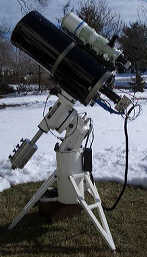 I
used this setup from 2003 until 2007. It consisted of a 12.1" f/9.3 R C
Optical Systems Ritchey-Chretien including field flattener and rotator, an SBIG
STL11000 CCD camera including the adaptive optics unit (AO-L) on Don Goldman's
manual off-axis guider (MOAG), and an AstroPhysics AP1200GTO-CP3, the King of
portable equatorial mounts. All this sits on Advanced Telescope Systems (ATS)
piers - I use their portable pier at Cherry Springs State Park PA or wherever
I travel and I also have their permanent pier at my getaway home in the Pocono
Mountains of Pennsylvania, the Pocono Palace. I recently acquired a Takahashi
Epsilon E-180 for wide field imaging but it's not yet integrated into the system.
I
used this setup from 2003 until 2007. It consisted of a 12.1" f/9.3 R C
Optical Systems Ritchey-Chretien including field flattener and rotator, an SBIG
STL11000 CCD camera including the adaptive optics unit (AO-L) on Don Goldman's
manual off-axis guider (MOAG), and an AstroPhysics AP1200GTO-CP3, the King of
portable equatorial mounts. All this sits on Advanced Telescope Systems (ATS)
piers - I use their portable pier at Cherry Springs State Park PA or wherever
I travel and I also have their permanent pier at my getaway home in the Pocono
Mountains of Pennsylvania, the Pocono Palace. I recently acquired a Takahashi
Epsilon E-180 for wide field imaging but it's not yet integrated into the system.
This system operates unattended so I can
get a decent night's sleep either in my van when portable or in the Palace when
I'm up there. I use my own CCDNavigator
for selecting targets and planning imaging sessions and CCDAutoPilot3
for executing them. In addition I use the RCOS TCC to manage the telescope
fans, focuser and rotator, FocusMax for focusing, PoleAlignMax for getting polar
aligned, MaxImDL for camera control and TheSky6 for mount control.
Clear Skies!
Steve...
 This
is my current setup consisting of a 16" f/8.3 R C Optical Systems Ritchey-Chretien
including field flattener and rotator, an SBIG STL11000M CCD camera including
the adaptive optics unit (AO-L) on Don Goldman's manual off-axis guider (MOAG),
and an AstroPhysics AP1200GTO-CP3. All this sits on Advanced Telescope Systems
(ATS) piers - I use their portable pier at Cherry Springs State Park PA or wherever
I travel and I also have their permanent pier at my getaway home in the Pocono
Mountains of Pennsylvania, the Pocono Palace. I recently acquired a Takahashi
Epsilon E-180 for wide field imaging but it's not yet integrated into the system.
This
is my current setup consisting of a 16" f/8.3 R C Optical Systems Ritchey-Chretien
including field flattener and rotator, an SBIG STL11000M CCD camera including
the adaptive optics unit (AO-L) on Don Goldman's manual off-axis guider (MOAG),
and an AstroPhysics AP1200GTO-CP3. All this sits on Advanced Telescope Systems
(ATS) piers - I use their portable pier at Cherry Springs State Park PA or wherever
I travel and I also have their permanent pier at my getaway home in the Pocono
Mountains of Pennsylvania, the Pocono Palace. I recently acquired a Takahashi
Epsilon E-180 for wide field imaging but it's not yet integrated into the system.






 I
also did a lot of barndoor photography, first with a manually driven hand crank
(I still have this and use it on occasion) and later with the slick little homemade
motorized barndoor shown here. This barndoor has been around the world several
times including two trips to Australia. It uses a curved bolt drive.
I
also did a lot of barndoor photography, first with a manually driven hand crank
(I still have this and use it on occasion) and later with the slick little homemade
motorized barndoor shown here. This barndoor has been around the world several
times including two trips to Australia. It uses a curved bolt drive.  At
the outset, I tried this with my LX50 Mak and a Meade 410XT CCD camera but this
proved to be an impossibility due to the pathetic drive in the LX50 and its
slow f/15 optics. There was around 120 arcseconds of periodic error and much
of it was very erratic and fast which made it impossible to guide accurately.
I also tried to use the Meade 201XT autoguider, a nightmare I hope others will
avoid. The 201XT holds the record as the least usable product in this hobby.
I could write a book about this. If you want to autoguide, get the SBIG ST-4
or STV. This photo shows what I wanted to do to my 201XT (kudos to Rich Michaels
who actually smashed his 201XT out of frustration).
At
the outset, I tried this with my LX50 Mak and a Meade 410XT CCD camera but this
proved to be an impossibility due to the pathetic drive in the LX50 and its
slow f/15 optics. There was around 120 arcseconds of periodic error and much
of it was very erratic and fast which made it impossible to guide accurately.
I also tried to use the Meade 201XT autoguider, a nightmare I hope others will
avoid. The 201XT holds the record as the least usable product in this hobby.
I could write a book about this. If you want to autoguide, get the SBIG ST-4
or STV. This photo shows what I wanted to do to my 201XT (kudos to Rich Michaels
who actually smashed his 201XT out of frustration). Anyway,
in 1998, I cashed in the LX50 and bought the system you see here. The MI-250
is a terrific mounting that can carry all sorts of optical tubes. The MI-250
has only 6-7 arcseconds of periodic error, what an amazing mount.My first OTA
for the MI-250 was the Meade 12" f/10 SCT. I started out using it for astrophotography
along with the Lumicon Giant Easy Guider but the images just weren't as good
as I was seeking, the star images were bloated and irregular due to coma and
other abberations. But the 12" is good for visual observing so I still
have it.
Anyway,
in 1998, I cashed in the LX50 and bought the system you see here. The MI-250
is a terrific mounting that can carry all sorts of optical tubes. The MI-250
has only 6-7 arcseconds of periodic error, what an amazing mount.My first OTA
for the MI-250 was the Meade 12" f/10 SCT. I started out using it for astrophotography
along with the Lumicon Giant Easy Guider but the images just weren't as good
as I was seeking, the star images were bloated and irregular due to coma and
other abberations. But the 12" is good for visual observing so I still
have it. This
is my BRC-250 AP1200 6x9 film setup. The Takahashi BRC-250 is a 10" f/5
astrograph (Baker-Ritchie-Chretien) that I purchased during August 2000 from
Herb York at Anacortes. The mounting is an Astro Physics AP1200GTO that I purchased
used during 2002. The Mitsuboshi off-axis guider couples to an STV for guiding
and to a 6x9 vacuum film back. This came from Ted Ishikawa at Hutech. I use
two film backs, each have purge and vacuum fittings.. The vacuum keeps the 6x9
film flat against the backplate. On the ground to the right is the nitrogen
tank and the vacuum pump. The STV and my notebook PC are sitting on a homemade
stand that doubles as a cart for the battery (next to the nitrogen tank). The
pier is the Advanced Telescope Systems 10" pier with a height of 30".
The battery is a deep cycle marine battery with 180 A-H rating. It can get me
through a night easily, sometime two. Built into the battery box is a dew controller
that measures the temperature of the optics and that of the air. It keeps the
optics slightly warmer than the air so dew does not form.
This
is my BRC-250 AP1200 6x9 film setup. The Takahashi BRC-250 is a 10" f/5
astrograph (Baker-Ritchie-Chretien) that I purchased during August 2000 from
Herb York at Anacortes. The mounting is an Astro Physics AP1200GTO that I purchased
used during 2002. The Mitsuboshi off-axis guider couples to an STV for guiding
and to a 6x9 vacuum film back. This came from Ted Ishikawa at Hutech. I use
two film backs, each have purge and vacuum fittings.. The vacuum keeps the 6x9
film flat against the backplate. On the ground to the right is the nitrogen
tank and the vacuum pump. The STV and my notebook PC are sitting on a homemade
stand that doubles as a cart for the battery (next to the nitrogen tank). The
pier is the Advanced Telescope Systems 10" pier with a height of 30".
The battery is a deep cycle marine battery with 180 A-H rating. It can get me
through a night easily, sometime two. Built into the battery box is a dew controller
that measures the temperature of the optics and that of the air. It keeps the
optics slightly warmer than the air so dew does not form.